What We’re Reading: June 23rd
 This week’s What We’re Reading is guest edited by Gaby Auge, a Senior Research Associate at Fundación Instituto Leloir, IIBBA-CONICET (www.leloir.org.ar), in Buenos Aires, Argentina.
This week’s What We’re Reading is guest edited by Gaby Auge, a Senior Research Associate at Fundación Instituto Leloir, IIBBA-CONICET (www.leloir.org.ar), in Buenos Aires, Argentina.
Gaby’s research interests focus on how environmental changes shape plant responses (plasticity), and the ecological and evolutionary consequences such plasticity may have. Gaby is also interested in science communication to fight “plant blindness”.
Contributors: Gaby Auge, Belén Oldra, Aimé Jaskolowski, Mariana Antonietti, Maximiliano Sánchez-Lamas, Lindsay Leverett
Review: Floral phenology shapes bee populations and communities ($)
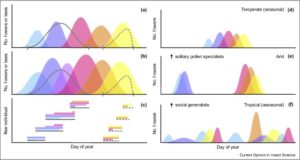 Many plants depend on pollinators, but the pollinators’ dependency on plants is often overseen. In this review, Ogilvie and Forrest discuss how pollinator populations and communities depend on plant phenology for their survival. Floral resource phenology—temporal distribution of floral species available to a certain pollinator population—must be matched with pollinator foraging phenologies for the mutualism to be successful. When floral resources (frequency, abundance, timing) and pollinator foraging phenologies are mistimed due to either climate change or alterations to habitats associated with agricultural and urban landscapes, there are fitness consequences to both plants and pollinators. Unfortunately, we are lacking empirical work on bee fitness responses to changes in plant phenology. The authors suggest some studies that could be done to help us better understand how pollinator-plant relationships co-evolved and to shed light on pollinator responses to climate change. (Summary by Gaby Auge). Curr. Opin. Insect Sci., doi: 10.1016/j.cois.2017.05.015
Many plants depend on pollinators, but the pollinators’ dependency on plants is often overseen. In this review, Ogilvie and Forrest discuss how pollinator populations and communities depend on plant phenology for their survival. Floral resource phenology—temporal distribution of floral species available to a certain pollinator population—must be matched with pollinator foraging phenologies for the mutualism to be successful. When floral resources (frequency, abundance, timing) and pollinator foraging phenologies are mistimed due to either climate change or alterations to habitats associated with agricultural and urban landscapes, there are fitness consequences to both plants and pollinators. Unfortunately, we are lacking empirical work on bee fitness responses to changes in plant phenology. The authors suggest some studies that could be done to help us better understand how pollinator-plant relationships co-evolved and to shed light on pollinator responses to climate change. (Summary by Gaby Auge). Curr. Opin. Insect Sci., doi: 10.1016/j.cois.2017.05.015
Temperature-modulated flowering mediated by histone methylation and alternative splicing
 Plants have the capacity to adjust their biochemical makeup in order to adapt and survive. Temperature changes can severely affect flowering time and reproductive success. Alternative splicing of pre-messenger RNA (mRNA) is an important mechanism underlying ambient temperature-controlled responses in plants, yet its regulation is poorly understood. The work presented by Pajoro et al. associated changes in the deposition of methylation marks in the Histone 3 lysine 36 (H3K36) after increasing temperature with mRNA processing (alternative splicing), suggesting a role of this histone mark in plasticity to this environmental cue. Additionally, they showed how this histone modification affects ambient temperature-induced alternative splicing of many key regulatory genes, including various flowering-time regulators. It is attractive to hypothesize that temperature variation is maintained in the chromatin landscape via H3K36me3 deposition, “which allows the memory of environmental conditions during the life cycle and a possible adaptation to a rapidly changing climate.” (Summary by Belén Oldrá). Genome Biology, doi: 10.1186/s13059-017-1235-x
Plants have the capacity to adjust their biochemical makeup in order to adapt and survive. Temperature changes can severely affect flowering time and reproductive success. Alternative splicing of pre-messenger RNA (mRNA) is an important mechanism underlying ambient temperature-controlled responses in plants, yet its regulation is poorly understood. The work presented by Pajoro et al. associated changes in the deposition of methylation marks in the Histone 3 lysine 36 (H3K36) after increasing temperature with mRNA processing (alternative splicing), suggesting a role of this histone mark in plasticity to this environmental cue. Additionally, they showed how this histone modification affects ambient temperature-induced alternative splicing of many key regulatory genes, including various flowering-time regulators. It is attractive to hypothesize that temperature variation is maintained in the chromatin landscape via H3K36me3 deposition, “which allows the memory of environmental conditions during the life cycle and a possible adaptation to a rapidly changing climate.” (Summary by Belén Oldrá). Genome Biology, doi: 10.1186/s13059-017-1235-x
Transgenerational effects of mild heat correlate with climate of origin ($)
 A continuously growing body of evidence shows that the expression of phenotypes is not only a response to genotype-by-environment interactions within a generation, but also a consequence of the environment experienced by previous generations. However, how transgenerational effects interact throughout different generations [grandparental (GP) and parental (P) effects] to determine offspring phenotypes is largely unknown. Groot et al. studied transgenerational responses to mild heat in 14 Arabidopsis thaliana genotypes from diverse geographical origins, and correlated those effects with climate of origin. They found strong negative transgenerational effects of mild heat on fitness (reproductive biomass), while seed size and rosette diameter were positively affected in the offspring. On the other hand, mild heat accelerated flowering time in offspring, which may help future generations to avoid early onset of summer and shorter growing seasons. All these were affected by GP, P or GP+P effects, and were genotype-specific and highly correlated with climate of origin. Their results suggest that GP effects act on offspring phenotypic plasticity by affecting parental response to its own environment. This also indicates that adaptation to increasing temperatures and decreasing precipitation during summer has already started, at least in this winter annual species. (Summary by Gaby Auge). New Phytol. doi: 10.1111/nph.14642
A continuously growing body of evidence shows that the expression of phenotypes is not only a response to genotype-by-environment interactions within a generation, but also a consequence of the environment experienced by previous generations. However, how transgenerational effects interact throughout different generations [grandparental (GP) and parental (P) effects] to determine offspring phenotypes is largely unknown. Groot et al. studied transgenerational responses to mild heat in 14 Arabidopsis thaliana genotypes from diverse geographical origins, and correlated those effects with climate of origin. They found strong negative transgenerational effects of mild heat on fitness (reproductive biomass), while seed size and rosette diameter were positively affected in the offspring. On the other hand, mild heat accelerated flowering time in offspring, which may help future generations to avoid early onset of summer and shorter growing seasons. All these were affected by GP, P or GP+P effects, and were genotype-specific and highly correlated with climate of origin. Their results suggest that GP effects act on offspring phenotypic plasticity by affecting parental response to its own environment. This also indicates that adaptation to increasing temperatures and decreasing precipitation during summer has already started, at least in this winter annual species. (Summary by Gaby Auge). New Phytol. doi: 10.1111/nph.14642
Extinction-colonization balance and range shifts of North American trees ($)
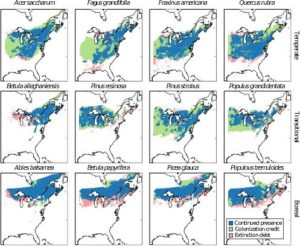 Distributions of species across the globe depends on climatic conditions, therefore, climate change is expected to result in species range shifts and biodiversity changes in certain ecosystems. Long-lived, slow species such as trees are extremely vulnerable to climate change as their responses may lag behind changing conditions. Talluto et al. used a dynamic model that analyzes the balance of extinction and colonization to assess range shifts in response to climate change of 21 dominant trees across temperate, transitional and boreal forests in eastern North America. By comparing current distributions and long-term equilibria from their metapopulation model with forest inventory data, they found extensive areas of extinction debt (current presence, predicted long-term absence) on the southern limit of current ranges, but they observed colonization credit (current absence, predicted long-term presence) on western and northern edges. However, range expansion will happen slowly due to the high longevity of the trees and the slow colonization of the northern edge, meaning that temperature increases is likely to outpace distributional changes. (Summary by Gaby Auge). Nature Ecol. Evol. doi: 10.1038/s41559-017-0182
Distributions of species across the globe depends on climatic conditions, therefore, climate change is expected to result in species range shifts and biodiversity changes in certain ecosystems. Long-lived, slow species such as trees are extremely vulnerable to climate change as their responses may lag behind changing conditions. Talluto et al. used a dynamic model that analyzes the balance of extinction and colonization to assess range shifts in response to climate change of 21 dominant trees across temperate, transitional and boreal forests in eastern North America. By comparing current distributions and long-term equilibria from their metapopulation model with forest inventory data, they found extensive areas of extinction debt (current presence, predicted long-term absence) on the southern limit of current ranges, but they observed colonization credit (current absence, predicted long-term presence) on western and northern edges. However, range expansion will happen slowly due to the high longevity of the trees and the slow colonization of the northern edge, meaning that temperature increases is likely to outpace distributional changes. (Summary by Gaby Auge). Nature Ecol. Evol. doi: 10.1038/s41559-017-0182
BAF60 mediates seedling growth control by modulating DNA accessibility
 Not having the capacity to move to more favorable places, plants have developed mechanisms that allow them to respond quickly to changes in the environment, integrating information from a series of external stimuli such as light and temperature. These mechanisms function at different levels, for example by regulating gene expression by the binding of transcription factors to certain sites in the genome, or by regulating the extent of chromatin compaction. In this work, Jégu et al. focus on how the accessibility of chromatin to transcriptional regulators alters gene expression in Arabidopsis. BAF60, a component of the chromatin remodeling machinery, binds to nucleosomes-free regions rich in G-box motifs. BAF60 binding prevents PIF4 (a transcription factor responsible for the induction of hypocotyl growth in response to light and temperature) from binding to those G-boxes. This makes BAF60 a growth regulator. This finding shows that growth regulation occurs through several mechanisms that alter gene expression, either by the direct binding of a transcriptional regulator to DNA, or by inhibiting the activity of transcription factors by blocking its specific binding sites in the DNA. (Summary by Maximiliano Sánchez-Lamas). Genome Biol. doi: 10.1186/s13059-017-1246-7
Not having the capacity to move to more favorable places, plants have developed mechanisms that allow them to respond quickly to changes in the environment, integrating information from a series of external stimuli such as light and temperature. These mechanisms function at different levels, for example by regulating gene expression by the binding of transcription factors to certain sites in the genome, or by regulating the extent of chromatin compaction. In this work, Jégu et al. focus on how the accessibility of chromatin to transcriptional regulators alters gene expression in Arabidopsis. BAF60, a component of the chromatin remodeling machinery, binds to nucleosomes-free regions rich in G-box motifs. BAF60 binding prevents PIF4 (a transcription factor responsible for the induction of hypocotyl growth in response to light and temperature) from binding to those G-boxes. This makes BAF60 a growth regulator. This finding shows that growth regulation occurs through several mechanisms that alter gene expression, either by the direct binding of a transcriptional regulator to DNA, or by inhibiting the activity of transcription factors by blocking its specific binding sites in the DNA. (Summary by Maximiliano Sánchez-Lamas). Genome Biol. doi: 10.1186/s13059-017-1246-7
Influence of Phytochrome B on nucleus size and heterochromatin organization
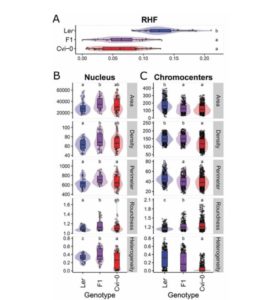 Natural variation in Arabidopsis underpins its ability to adapt to diverse environmental conditions. Snoek et al. have studied the genetic variation of nucleus size and hetereochromatin condensation. Some of the chromatin organization differences can be attributed to variation in the gene encoding Phytochrome B, which is an important photoreceptor and thermosensor responsible for regulating growth. These results indicate that natural polymorphisms of Phytochrome B, which acts as a hub for environmental sensing, are reflected in changes in the proportion of transcriptionally active or inactive zones in the nucleus of the cells. (Summary by Maximiliano Sánchez-Lamas). G3, doi: 10.1534/g3.117.043539
Natural variation in Arabidopsis underpins its ability to adapt to diverse environmental conditions. Snoek et al. have studied the genetic variation of nucleus size and hetereochromatin condensation. Some of the chromatin organization differences can be attributed to variation in the gene encoding Phytochrome B, which is an important photoreceptor and thermosensor responsible for regulating growth. These results indicate that natural polymorphisms of Phytochrome B, which acts as a hub for environmental sensing, are reflected in changes in the proportion of transcriptionally active or inactive zones in the nucleus of the cells. (Summary by Maximiliano Sánchez-Lamas). G3, doi: 10.1534/g3.117.043539
Germination phenology determines the propensity for facilitation and competition ($)
 Plants can interact negatively or positively with their neighbors depending on the environments they experience. Under physical stress, positive interactions (facilitation) become more likely and can dominate negative interactions (competition). My working hypothesis was that in winter-annual species that germinate in autumn, later germination will increase the chance that individuals will be exposed to cold temperatures during the seedling stage and in turn such individuals will be more likely to receive facilitation from their neighbors. The hypothesis was supported in one year in which late germination led to cold-induced mortality but not in another year in which late germination was more permissive for survival. These results indicate that the timing of germination can create a temporal stress gradient along which the effects of neighbors on focal plants can change not only magnitude but also direction. (Summary by Lindsay Leverett). Ecology, doi: 10.1002/ecy.1933
Plants can interact negatively or positively with their neighbors depending on the environments they experience. Under physical stress, positive interactions (facilitation) become more likely and can dominate negative interactions (competition). My working hypothesis was that in winter-annual species that germinate in autumn, later germination will increase the chance that individuals will be exposed to cold temperatures during the seedling stage and in turn such individuals will be more likely to receive facilitation from their neighbors. The hypothesis was supported in one year in which late germination led to cold-induced mortality but not in another year in which late germination was more permissive for survival. These results indicate that the timing of germination can create a temporal stress gradient along which the effects of neighbors on focal plants can change not only magnitude but also direction. (Summary by Lindsay Leverett). Ecology, doi: 10.1002/ecy.1933
Low rate of somatic mutation in a long-lived oak tree
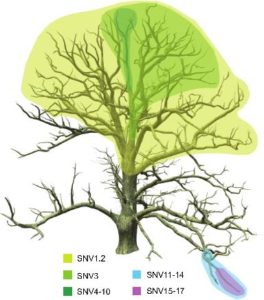 Replication errors during cell division of certain cells of the meristems may give rise to somatic mutations in independent sectors of a same plant. Those mutations might be fixed and passed on to the next generation if the affected meristems develop reproductive structures in long-lived plants such as trees. To investigate the incidence and potential fixing of such somatic mutations, Sarkar et al. sequenced leaves from distant branches of a 234 year-old oak tree to analyze the presence of single-nucleotide variants (SNV). They found only a small number of SNVs, lower than the number expected by the mutation rate of the species. The distribution of the SNVs was restricted to some ramifications in a nested hierarchy that agrees with accumulation of mutations during development. The most frequent mutations observed were the kind induced by UV exposure, suggesting SNVs are consequence of environmentally-induced mutations rather than derived from replication errors. The overall low frequency of SNVs indicate that meristems in trees, although vulnerable to environmentally-induced mutations, are well protected, at least more than predicted. (Summary by Gaby Auge). bioRxiv, doi: 10.1101/149203
Replication errors during cell division of certain cells of the meristems may give rise to somatic mutations in independent sectors of a same plant. Those mutations might be fixed and passed on to the next generation if the affected meristems develop reproductive structures in long-lived plants such as trees. To investigate the incidence and potential fixing of such somatic mutations, Sarkar et al. sequenced leaves from distant branches of a 234 year-old oak tree to analyze the presence of single-nucleotide variants (SNV). They found only a small number of SNVs, lower than the number expected by the mutation rate of the species. The distribution of the SNVs was restricted to some ramifications in a nested hierarchy that agrees with accumulation of mutations during development. The most frequent mutations observed were the kind induced by UV exposure, suggesting SNVs are consequence of environmentally-induced mutations rather than derived from replication errors. The overall low frequency of SNVs indicate that meristems in trees, although vulnerable to environmentally-induced mutations, are well protected, at least more than predicted. (Summary by Gaby Auge). bioRxiv, doi: 10.1101/149203
The level of carbon and nitrogen assimilation during the day determines the leaf respiration rate during the night
 Plants generate molecular energy by two processes: photosynthesis during the daytime and respiration mostly during the night. For respiration to occur, it is necessary that the plant has respirable metabolites (mostly carbohydrates). It is known that respiration rates vary between species, even if they are growing in the same environment. O’Leary et al. saw that despite the genetic similarities of the plants studied, they vary in their respiration rates. The authors propose that the amount of respirable metabolites produced during the day and the energetic cost of the transportation of nutrients are the two major variables that explain the differences. (Summary by Aimé Jaskolowski). Plant Physiology, doi: 10.1104/pp.17.00610
Plants generate molecular energy by two processes: photosynthesis during the daytime and respiration mostly during the night. For respiration to occur, it is necessary that the plant has respirable metabolites (mostly carbohydrates). It is known that respiration rates vary between species, even if they are growing in the same environment. O’Leary et al. saw that despite the genetic similarities of the plants studied, they vary in their respiration rates. The authors propose that the amount of respirable metabolites produced during the day and the energetic cost of the transportation of nutrients are the two major variables that explain the differences. (Summary by Aimé Jaskolowski). Plant Physiology, doi: 10.1104/pp.17.00610
Genetic control of plasticity of rice root morphology and anatomy
 Because water deficits are expected to become more common as a consequence of global climate change, it is important to understand the genetic mechanisms behind plants adaptations to drought conditions. Rice is one of the leading food crops in the world so the need for cultivars that are productive under water deficit conditions is imperative. Kadam et al. propose to go beyond studying conventional traits and concentrate on phenotypic plasticity to find new ways plants can resist dehydration. To assess phenotypic plasticity, the authors compared a set of 35 traits mostly related to root morphology and anatomy in a diverse panel of rice indica genotypes grown under water deficit and control conditions. To link the phenotypic data to genomic regions, a genome-wide association analysis using approximately 45.000 SNPs was performed. The authors found several significant loci for phenotypic plasticity and a priori candidate genes regulating root growth and development, proving that variation in traits can provide novel genetic insight potentially useful for breeding programs in the search for high-yielding cultivars grown in stress conditions. (Summary by Mariana Antonietti). Plant Physiology, doi: 10.1104/pp.17.00500
Because water deficits are expected to become more common as a consequence of global climate change, it is important to understand the genetic mechanisms behind plants adaptations to drought conditions. Rice is one of the leading food crops in the world so the need for cultivars that are productive under water deficit conditions is imperative. Kadam et al. propose to go beyond studying conventional traits and concentrate on phenotypic plasticity to find new ways plants can resist dehydration. To assess phenotypic plasticity, the authors compared a set of 35 traits mostly related to root morphology and anatomy in a diverse panel of rice indica genotypes grown under water deficit and control conditions. To link the phenotypic data to genomic regions, a genome-wide association analysis using approximately 45.000 SNPs was performed. The authors found several significant loci for phenotypic plasticity and a priori candidate genes regulating root growth and development, proving that variation in traits can provide novel genetic insight potentially useful for breeding programs in the search for high-yielding cultivars grown in stress conditions. (Summary by Mariana Antonietti). Plant Physiology, doi: 10.1104/pp.17.00500
Temperature information integrated by a spatially embedded decision-making center in seeds
 Seed germination at the wrong time may lead to reduced plant fitness or, even worst, mortality, so the decision of when to germinate is crucial. Germination is influenced by the level of seed dormancy, which in turn is modulated by the balance between the amount of and response to the hormones giberellin (GA) and abscisic acid (ABA). Through mathematical modelling, Topham et al. studied the interactions between GA and ABA underlying the control of seed dormancy. Their model shows that there is a bistable developmental fate-switch towards reduced dormancy governed by removal of ABA or addition of GA. This switch can be physically localized in few cells of the embryo radicle, in which the distribution and response to environmental temperature changes is spatially embedded, providing an unparalleled information-processing capacity to the seeds. Although input processing might differ, the topological configuration of the seed’s decision center shows similarities at the cellular with that of the human brain. (Summary by Gaby Auge). Proc. Natl. Acad. Sci. USA, doi: 10.1073/pnas.1704745114
Seed germination at the wrong time may lead to reduced plant fitness or, even worst, mortality, so the decision of when to germinate is crucial. Germination is influenced by the level of seed dormancy, which in turn is modulated by the balance between the amount of and response to the hormones giberellin (GA) and abscisic acid (ABA). Through mathematical modelling, Topham et al. studied the interactions between GA and ABA underlying the control of seed dormancy. Their model shows that there is a bistable developmental fate-switch towards reduced dormancy governed by removal of ABA or addition of GA. This switch can be physically localized in few cells of the embryo radicle, in which the distribution and response to environmental temperature changes is spatially embedded, providing an unparalleled information-processing capacity to the seeds. Although input processing might differ, the topological configuration of the seed’s decision center shows similarities at the cellular with that of the human brain. (Summary by Gaby Auge). Proc. Natl. Acad. Sci. USA, doi: 10.1073/pnas.1704745114
High-throughput phenotyping for biomass crops
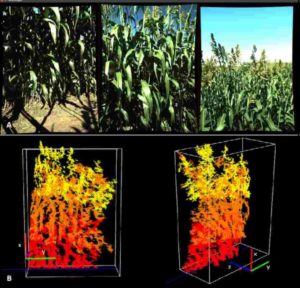 High-throughput phenotyping of tall dense crops like sorghum is challenging, with planting density and the choice of morphological traits to be assessed affecting data collection outcome. Salas Fernandez et al. report on the development of Phenobot, a novel ground-based platform with navigation and auto-steering system that can collect data from a 1.5 hectare field in only 3 hours. The Phenobot is loaded with stereo cameras (that enable 3D plant reconstructions) on an extensible rig for image data collection, which is then analyzed with algorithms generated by the authors. Phenobot collects data with high repeatability (small deviation from the mean for a given trait and a same genotype/line), with no statistical difference in results of GWAS from manually or automatically collected height data. Their analysis indicates that the data processing algorithm is most efficient and robust when images are automatically collected. The reliability and versatility of the system allows for its repeated use in a single season, in addition to the possibility of increasing data collection by including other kind of loggers. (Summary by Gaby Auge). Plant Physiol. doi: 10.1104/pp.17.00707
High-throughput phenotyping of tall dense crops like sorghum is challenging, with planting density and the choice of morphological traits to be assessed affecting data collection outcome. Salas Fernandez et al. report on the development of Phenobot, a novel ground-based platform with navigation and auto-steering system that can collect data from a 1.5 hectare field in only 3 hours. The Phenobot is loaded with stereo cameras (that enable 3D plant reconstructions) on an extensible rig for image data collection, which is then analyzed with algorithms generated by the authors. Phenobot collects data with high repeatability (small deviation from the mean for a given trait and a same genotype/line), with no statistical difference in results of GWAS from manually or automatically collected height data. Their analysis indicates that the data processing algorithm is most efficient and robust when images are automatically collected. The reliability and versatility of the system allows for its repeated use in a single season, in addition to the possibility of increasing data collection by including other kind of loggers. (Summary by Gaby Auge). Plant Physiol. doi: 10.1104/pp.17.00707
CONTRIBUTORS:
 Gaby Auge, @gabyplantbio, gabyauge.weebly.com: “I’m a Senior Postdoc Researcher at Fundación Instituto Leloir (Buenos Aires, Argentina). My work is focused on understanding how plants adjust their life cycles to the seasons and how they respond to environmental changes.”
Gaby Auge, @gabyplantbio, gabyauge.weebly.com: “I’m a Senior Postdoc Researcher at Fundación Instituto Leloir (Buenos Aires, Argentina). My work is focused on understanding how plants adjust their life cycles to the seasons and how they respond to environmental changes.”
 Belén Oldrá, www.leloir.org.ar/cerdan/: “I’m a molecular biologist graduated from the University of San Luis, Argentina. My interest in plant science was revealed when I attended a course while I was an undergrad. That’s why I decided to move to Buenos Aires and start a PhD at the Leloir Institute, in Pablo Cerdan´s lab. My PhD is focused on studying the genetic mechanisms controlling the relationship between DNA replication and establishment of epigenetic marks in response to temperature changes.”
Belén Oldrá, www.leloir.org.ar/cerdan/: “I’m a molecular biologist graduated from the University of San Luis, Argentina. My interest in plant science was revealed when I attended a course while I was an undergrad. That’s why I decided to move to Buenos Aires and start a PhD at the Leloir Institute, in Pablo Cerdan´s lab. My PhD is focused on studying the genetic mechanisms controlling the relationship between DNA replication and establishment of epigenetic marks in response to temperature changes.”
 Maximiliano Sánchez-Lamas, www.leloir.org.ar/cerdan/: “I’m a Postdoc Researcher at Fundación Instituto Leloir (Buenos Aires, Argentina). Mainly, I am interested in how members of multigenic photoreceptor families have diverged from one another to regulate different functions, and which are the emerging properties that depend on the existence of more than one member of these families.”
Maximiliano Sánchez-Lamas, www.leloir.org.ar/cerdan/: “I’m a Postdoc Researcher at Fundación Instituto Leloir (Buenos Aires, Argentina). Mainly, I am interested in how members of multigenic photoreceptor families have diverged from one another to regulate different functions, and which are the emerging properties that depend on the existence of more than one member of these families.”
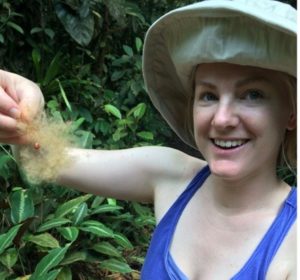 Lindsay D. Leverett, lindsayleverett.weebly.com: “Lindsay D. Leverett is a Ph.D. Candidate in Ecology at Duke University, where she works with Dr. Kathleen Donohue. She has also worked with Dr. Claudia Jolls at East Carolina University, Dr. Michael Woods at Troy University, and Dr. Allison Shaw at the University of Minnesota-Twin Cities. Lindsay fell in love with the plant communities in the Southeastern United States as she was growing up in Alabama. She now spends most of her time thinking about how plants interact and whether she can afford to adopt more cats.”
Lindsay D. Leverett, lindsayleverett.weebly.com: “Lindsay D. Leverett is a Ph.D. Candidate in Ecology at Duke University, where she works with Dr. Kathleen Donohue. She has also worked with Dr. Claudia Jolls at East Carolina University, Dr. Michael Woods at Troy University, and Dr. Allison Shaw at the University of Minnesota-Twin Cities. Lindsay fell in love with the plant communities in the Southeastern United States as she was growing up in Alabama. She now spends most of her time thinking about how plants interact and whether she can afford to adopt more cats.”
 Aimé Jaskolowski, www.leloir.org.ar/cerdan/: “I’m a PhD student in the Molecular Plant Biology lab at Fundación Instituto Leloir (Buenos Aires, Argentina). My interest in molecular biology started when I was a high school student at the city of Bariloche. I moved to Buenos Aires to study biology and I felt in love with plants working as an undergrad student at Pablo Cerdan’s lab. My research is focused on the study of a major protein complex that interacts with the transcription machinery and plays an increasingly important role in different aspects of plant development.”
Aimé Jaskolowski, www.leloir.org.ar/cerdan/: “I’m a PhD student in the Molecular Plant Biology lab at Fundación Instituto Leloir (Buenos Aires, Argentina). My interest in molecular biology started when I was a high school student at the city of Bariloche. I moved to Buenos Aires to study biology and I felt in love with plants working as an undergrad student at Pablo Cerdan’s lab. My research is focused on the study of a major protein complex that interacts with the transcription machinery and plays an increasingly important role in different aspects of plant development.”
 Mariana Antonietti, www.leloir.org.ar/cerdan/: “I am currently pursuing a PhD in biology in Dr. Pablo Cerdan’s lab at Fundación Instituto Leloir (Buenos Aires, Argentina). I am passionate about plants. My thesis focuses on a series of novel synthetic compounds that affect early development in Arabidopsis thaliana.”
Mariana Antonietti, www.leloir.org.ar/cerdan/: “I am currently pursuing a PhD in biology in Dr. Pablo Cerdan’s lab at Fundación Instituto Leloir (Buenos Aires, Argentina). I am passionate about plants. My thesis focuses on a series of novel synthetic compounds that affect early development in Arabidopsis thaliana.”




Leave a Reply
Want to join the discussion?Feel free to contribute!